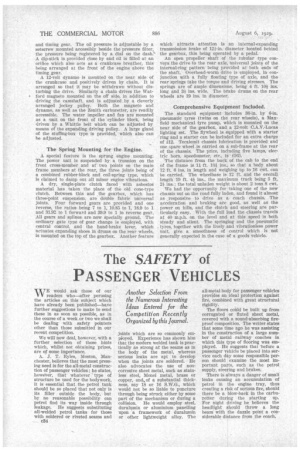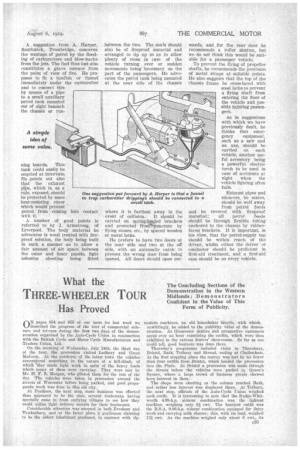The SAFETY of PASSENGER VEHICLES
Page 56

Page 57

If you've noticed an error in this article please click here to report it so we can fix it.
WE would ask those of our readers who—after perusing the articles on this subject which have already been published—have further suggestions to make to send these in as soon as possible, as in the course of a week or two we shall be dealing with safety pointers other than those submitted in our recent competition.
We will now deal, however, with a further selection of those hints which, whilst not obtaining prizes, are of some importance.
A. J. T. Eyles, Moston, Manchester, believes that the most pressing need is for the all-metal construction of passenger vehicles; he states, however, that whatever' type of structure be used for the bodywork, it is essential that the petrol tank should be so placed that not only is its filler outside the body, but by no reasonable possibility can petrol find its way inside through leakage. He suggests substituting all-welded petrol tanks for those with soldered or riveted seams and 034 joints which are so commonly employed. Experience has shown him that the modern welded tank is practically as strong at the seams as in the body of the metal, whereas serious leaks are apt to develop when the joints are soldered. He also advocates the use of noncorrosive sheet metal, such as stainless steel, MoneI metal, brass or copper, and, of a substantial thickness, say 18 or 16 S.W.G., which would not be so liable to puncture through being struck either by some part of the mechanism or during a collision. He would employ steel, duralutrin or aluminium panelling upon a framework of duralumin or other lightweight alloy. The all-metal body for passenger vehicles provides an ideal protection against fire, combined with great structural The floors could be built up from corrugated or fluted sheet metal, covered with a sound-absorbing fireproof composition. The writer states that some time ago he was assisting in the construction of a large number of metal railway coaches in which this type of flooring was employed. He suggests that 'before a passenger vehicle be placed into service each day some responsible person should examine the most important parts, such as the petrol supply, steering and brakes.
There is always a danger of small leaks causing an accumulation of petrol in the engine tray, thus creating a risk of serious fire, should there be a blow-back in the carburetter during the starting up. For night driving he believes the headlight should throw a long beam with the dazzle point a considerable distance from the coach.
• A suggestion from A. Harper, Southwick, Trowbridge, concerns the wastage of petrol by the flooding of carburetters and blow-backs from the jets. The fuel thus lost also constitutes a grave menace from the point of 'view of fire. He proposes to fit a tundish or funnel immediately under the carburetter and to connect this
by means of a pipe to a small auxiliary petrol tank mounted out of sight beneath the chassis or run nb.ig boards. This tank could easily be emptied at intervals. He points out also that the exhaust pipe, which is, as a rule, exposed, should
be protected by some heat-resisting cover which would prevent petrol from coming into contact with it.
A number . of good points is referred to by J. Armstrong, of Liverpool. The body material he advocates is wood treated with fireproof solution, the body being built in such a manner as to allow a fair amount of air space between The outer and inner panels, light asbestos sheeting being fitted between the two. The seats should also be of fireproof material and arranged to tip up so as to allow plenty of room in case of the vehicle turning , over or sudden movements being 'necessary on the part of the passengers. He advocates the petrol tank being mounted at the near side of the chassis
where it is farthest away in the
event of collision. It should be carried on spring-loaded brackets and Protected fromuncture by flYing stones, etc., by spaced wooden or metal laths.
He prefers to have two doors at the near Bide and two at the off side, with an automatic catch to prevent the wrong door from being opened. All doors should open out
wards, and for the rear door he recommends a roller shutter, but we do not think this would be suitable for a passenger vehicle.
To prevent the flying of propeller shafts, he recommends the provision of metal straps at suitable points. He also suggests that the top of the chassis frame be cross-laced with steel laths to prevent a flying shaft from entering the floor of the vehicle and possibly injuring passengers.
As in suggestions with which we have previously dealt, he thinks that emergency equipment, such as a saw and an axe, should be carried on each vehicle, another useful accessory being a powerful electric torch to be Used in case of accidents at night when the vehicle lighting often fails.
Exhaust pipes and silencers, he states, should be well away from petrol feeds and be covered with fireproof material; all petrol feeds should be through flexible tubing anchored to the chassis by rubberfaced brackets. It is important, in his view, that the petrol-supply tap should be within reach of the driver, whilst either the driver or el:inductor should be proficient in first-aid treatment, and a first-aid case should be on every vehicle.














































































































